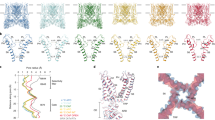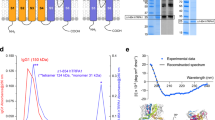Abstract
TRPA1 is an ion channel expressed by nociceptors and activated by irritant compounds such as mustard oil. The endogenous function of TRPA1 has remained unclear, a fact highlighted by ongoing debate over its potential role as a sensor of noxious cold. Here we show that intracellular Ca2+ activates human TRPA1 via an EF-hand domain and that cold sensitivity occurs indirectly (and nonphysiologically) through increased [Ca2+]i during cooling in heterologous systems.
This is a preview of subscription content, access via your institution
Access options
Subscribe to this journal
Receive 12 print issues and online access
$209.00 per year
only $17.42 per issue
Buy this article
- Purchase on Springer Link
- Instant access to full article PDF
Prices may be subject to local taxes which are calculated during checkout


Similar content being viewed by others
References
Jordt, S.E. et al. Nature 427, 260–265 (2004).
Nagata, K., Duggan, A., Kumar, G. & Garcia-Anoveros, J. J. Neurosci. 25, 4052–4061 (2005).
Nilius, B. et al. J. Physiol. (Lond.) 567, 35–44 (2005).
Nilius, B. et al. J. Biol. Chem. 278, 30813–30820 (2003).
Hofmann, T., Chubanov, V., Gudermann, T. & Montell, C. Curr. Biol. 13, 1153–1158 (2003).
Zhu, M.X. Pflugers Arch. 451, 105–115 (2005).
Nilius, B. et al. J. Biol. Chem. 280, 6423–6433 (2005).
Nelson, M.R. & Chazin, W.J. Biometals 11, 297–318 (1998).
Clapham, D.E. Nature 426, 517–524 (2003).
Story, G.M. et al. Cell 112, 819–829 (2003).
Bautista, D.M. et al. Cell 124, 1269–1282 (2006).
Kwan, K.Y. et al. Neuron 50, 277–289 (2006).
Talavera, K. et al. Nature 438, 1022–1025 (2005).
Reid, G. Pflugers Arch. 451, 250–263 (2005).
Bandell, M. et al. Neuron 41, 849–857 (2004).
Acknowledgements
We thank J.P. Adelman (Oregon Health & Science University) and S.E. Jordt (Yale University) for providing CaM1,2,3,4 and human TRPA1 clones, respectively, and C. Stein and G. Lewin for comments. Supported by Deutsche Forschungsgemeinschaft grants HE-4483 and KFO100.
Author information
Authors and Affiliations
Contributions
S.Z. and B.Y. conducted the electrophysiology and Ca2+ imaging experiments. J.A.J. conducted the CaM experiments, O.C. made the cell line, and S.Z., B.Y., J.A.J. and P.A.H. analyzed the data. P.A.H. wrote the manuscript.
Corresponding author
Ethics declarations
Competing interests
The authors declare no competing financial interests.
Supplementary information
Supplementary Fig. 1
Current traces of TRPA1 activation by Ca2+. (PDF 78 kb)
Supplementary Fig. 2
Calmodulin does not regulate activation of TRPA1 by Ca2+. (PDF 73 kb)
Supplementary Fig. 3
Cooling does not shift voltage dependent activation of TRPA1. (PDF 115 kb)
Rights and permissions
About this article
Cite this article
Zurborg, S., Yurgionas, B., Jira, J. et al. Direct activation of the ion channel TRPA1 by Ca2+. Nat Neurosci 10, 277–279 (2007). https://doi.org/10.1038/nn1843
Received:
Accepted:
Published:
Issue Date:
DOI: https://doi.org/10.1038/nn1843
This article is cited by
-
Role of TMEM100 in mechanically insensitive nociceptor un-silencing
Nature Communications (2023)
-
TRPA1 activation in non-sensory supporting cells contributes to regulation of cochlear sensitivity after acoustic trauma
Nature Communications (2023)
-
Molecular mechanism of hyperactivation conferred by a truncation of TRPA1
Nature Communications (2023)
-
Research Progress on TRPA1 in Diseases
The Journal of Membrane Biology (2023)
-
Irritant-evoked activation and calcium modulation of the TRPA1 receptor
Nature (2020)



